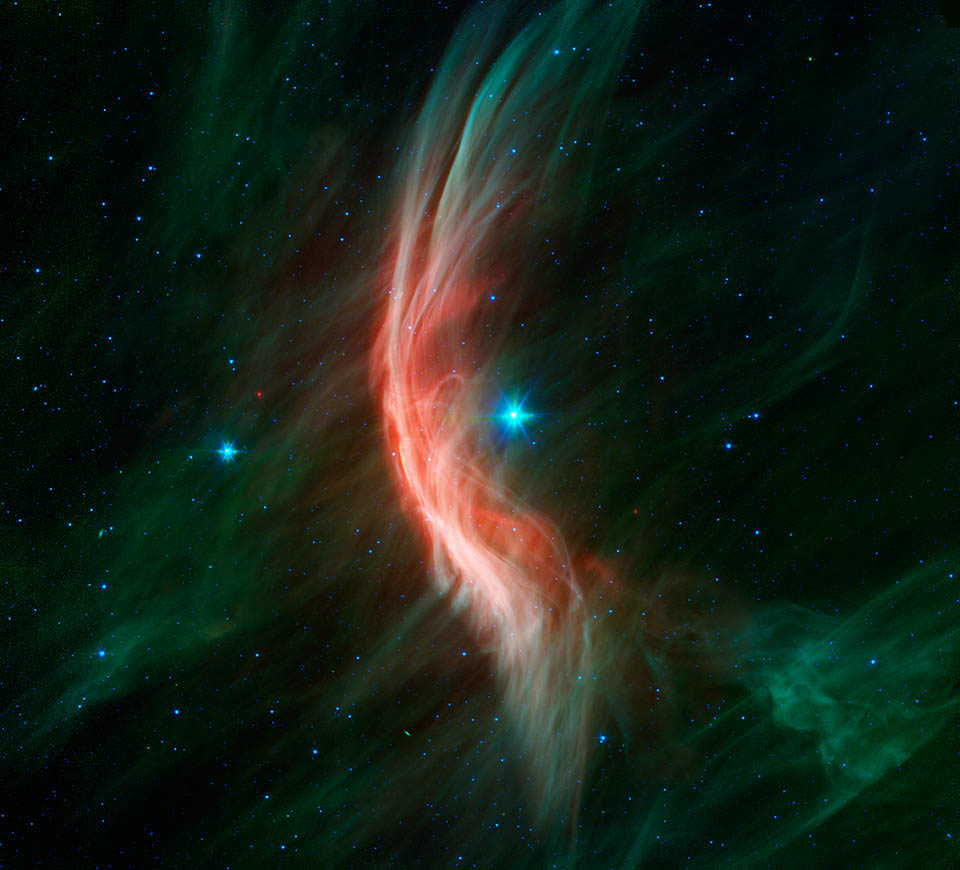The Milky Way can’t hold onto all of its stars. Some of them get ejected into intergalactic space and spend their lives on an uncertain journey. A team of astronomers took a closer look at the most massive of these runaway stars to see what they could find out how they get ejected.
When astronomers observe a field of stars in the Milky Way, one of the things they measure is the velocity distribution. The overall velocity distribution of the stellar population reflects the rotation of the galaxy. And when a star isn’t harmonized with the galaxy’s rotation, it catches astronomers’ attention.
A team of astronomers working with two catalogues of massive stars found a whole bunch of stars moving differently than the galaxy. They’re runaway stars that are on their way out of the galaxy.
The new findings are in a paper titled “Galactic runaway O and Be stars found using Gaia DR3.” It’ll be published in the journal Astronomy and Astrophysics, and the lead author is Mar Carretero Castrillo, a post-grad researcher in the Department of Quantum Physics and Astrophysics, Institute of Cosmos Sciences, University of Barcelona.
Castrillo and her colleagues based their work on two stellar catalogues. They’re the Galactic O-Star Catalog (GOSC) and the Be Star Spectra (BeSS). They’re both catalogues of different types of massive stars: O-type stars and Be-type stars, and their sub-types.
The researchers also used data from Gaia, the ESA’s powerful star-measuring spacecraft. It employs astrometry to measure the positions, distances, and motions of one billion stars. Gaia’s mission is changing astronomy by providing accurate, robust data that other researchers can use in their own research. This paper is based on a combination of Gaia data and data from the two catalogues.
Nobody knows how many runaway stars are on their way out of our galaxy, but astronomers keep finding more of them. Some estimates say there are 10 million runaway stars fleeing the Milky Way, but we don’t know for sure. It may depend on the mechanism that drives them away, and that’s something astrophysicists don’t fully understand.

This study aims to shed some light on the runaway star phenomenon by looking specifically at massive stars.
“A relevant fraction of massive stars are runaway stars. These stars move with a significant peculiar velocity with respect to their environment,” the authors explain. They set out to discover and characterize the runaway massive and early-type stars in both of the catalogues by examining Gaia data.
“Massive early-type OB stars are the most luminous stars in the Milky Way,” they explain. OB stars are not only massive and young, they’re extremely hot. They form in loosely organized groups with one another called OB associations. Because they’re young and hot, they don’t last long. They’re important in astronomy because they’re so massive and energetic and because many of them explode as supernovae. That’s why there are specific catalogues dedicated to them.
The team cross-referenced Gaia data with the GOSC and BeSS catalogues and came up with 417 O-type stars and 1335 Be-type stars present in both Gaia and the catalogues, respectively. Out of those, they found 106 type O runaway stars, which is 25.4 % of the stars in the GOSC catalogue. Forty-two of them are newly identified.
They found 69 Be runaway stars, which represent 5.2% of the stars in the Be-type star catalogue. Forty-seven of these are newly identified. Overall, the type-O stars move faster than the Be-type stars.
Why do massive stars make up such a high proportion of runaway stars? There are two competing theories that attempt to explain runaway stars, and both involve massive stars. One is the dynamical ejection scenario (DES), and the other is the binary supernova scenario (BSS).
OB stars often form in binary pairs. In the BSS, one star explodes as a supernova, and the explosion kicks the other star. If the situation is right, the surviving star is given enough energy in the right direction that it can escape from its bond with its partner, which is now a neutron star or a black hole. It can also escape the gravitational pull of the Milky Way. If that happens, it begins its long journey into intergalactic space.

In the DES, there’s no dramatic supernova explosion. Instead, a star in a compact, densely packed region experiences gravitational interactions with other stars. Encounters between binary and single stars can produce runaways, and so can encounters between two binary pairs. The OB associations where O-type and B-type stars tend to form are the types of dense environments that can trigger runaway stars. Since most of these stars are massive, most of the runaway stars are, too.

Scientists have been wondering about the two scenarios and debating them for decades. Both scenarios can produce stars with enough velocity to escape the galaxy. In studying their sample of 175 runaway stars, the researchers found that their data favours one explanation over the other.
“The higher percentages and higher velocities found for O-type compared to Be-type runaways underline that the dynamical ejection scenario is more likely than the binary supernova scenario,” they write.
The percentages of spectral types represented in runaway stars help explain their conclusion. 25% of the O-type stars in their sample are runaways versus 5% of the Be-type. Other studies have come up with different numbers, but as the authors point out, “there is agreement in the sense that the percentage of runaway O stars is significantly higher than for B or Be stars.”
Previous research shows that O-type runaway stars have higher velocities than B and Be-type stars. Previous research also shows that dynamical ejection often results in faster, more massive runaways than the binary supernova scenario. “The GOSC-Gaia DR3 stars have higher velocities in general than those in BeSS-Gaia DR3,” the authors explain, which lines up with the previous research.

“This reinforces the dominance of the DES scenario versus the BSS one,” they conclude.

